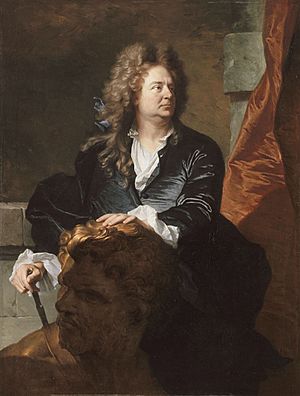Martin Desjardins facts for kids
Martin Desjardins was a famous sculptor from France, born in the Netherlands. His original name was Martin van den Bogaert. He lived from 1637 to 1694. He became well-known for creating beautiful statues and decorative plasterwork. Many of his important works were made for King Louis XIV of France.
Contents
Early Life and Training
Martin Desjardins was born in 1637 in a city called Breda in the Netherlands. His father was a milliner, which means he made and sold hats.
When he was young, Martin learned how to sculpt in Antwerp. He trained with a sculptor named Pieter Verbruggen. Later, in the 1650s, he moved to Paris, France, to continue his career.
Becoming a Master Sculptor
In Paris, Martin Desjardins first worked on decorative plaster designs. He created beautiful stucco reliefs for important buildings like the Hôtel d’Aubert de Fontenay.
In 1661, he joined a special art group called the Académie de Saint-Luc. He changed his name to "Martin Desjardins," which means "of the orchard" in French. This was a translation of his Dutch last name.
He became known for making monuments for people who had passed away. In 1671, he was accepted into the very important Académie royale de peinture et de sculpture. He showed a marble sculpture of Hercules Crowned by Glory to join this academy. This sculpture can now be seen in the Musée du Louvre.
Sculptures for the King
After joining the Royal Academy, Martin Desjardins started getting big projects from the King of France, Louis XIV. He created sculptures for important places like Les Invalides and the grand Palace of Versailles.
The king's artists often gave him drawings to follow. He even made several copies of the king's Roman statue, the Diana of Versailles.
The Louis XIV Victory Monument
One of his most famous works was a large monument for King Louis XIV. It was built in a square in Paris called the Place des Victoires. This monument celebrated the king's early military wins.
The monument included a tall statue of Louis XIV. At the base of the statue, there were four bronze figures. These figures represented the "Four Captive Nations." They celebrated the king's victories over Spain, the Holy Roman Empire, Brandenburg, and the Dutch Republic.
The main statue of Louis XIV was melted down during the French Revolution. But the "Captive Nations" figures were saved. They are now kept in the Louvre Museum. Their gold coating has worn off over time. You can also see a marble copy of the Louis XIV statue at Versailles.
Other Grand Statues
Martin Desjardins also created a large equestrian statue of Louis XIV for Lyon. This statue showed the king riding a horse. It was put up in 1713 in Place Bellecour.
Sadly, this statue was also destroyed during the French Revolution. However, the bronze figures from its base were saved. These figures showed the river gods of the Rhône and the Saône rivers, which meet in Lyon. They are now kept in the Hôtel de Ville in Lyon.
He also planned a third equestrian monument for Aix-en-Provence. He imagined the king on a rearing horse, supported only by its hind legs and tail. But this project was never built.
Portrait Busts
Besides large monuments, Martin Desjardins also made detailed portrait busts. A bust is a sculpture of a person's head and shoulders.
He made a marble bust of Pierre Mignard, who was the king's main painter. This bust was given to Mignard's daughter after her father passed away. Another grand marble bust he made was of the marquis de Villacerf. Both of these busts are now in the Louvre Museum.
Legacy
Martin Desjardins passed away in Paris in 1694. His nephew, Jacques Desjardins, continued his workshop. Jacques made plaster models that were used later to create an equestrian monument of Karl XII of Sweden in the 1740s.
See also
 In Spanish: Martin Desjardins para niños
In Spanish: Martin Desjardins para niños


